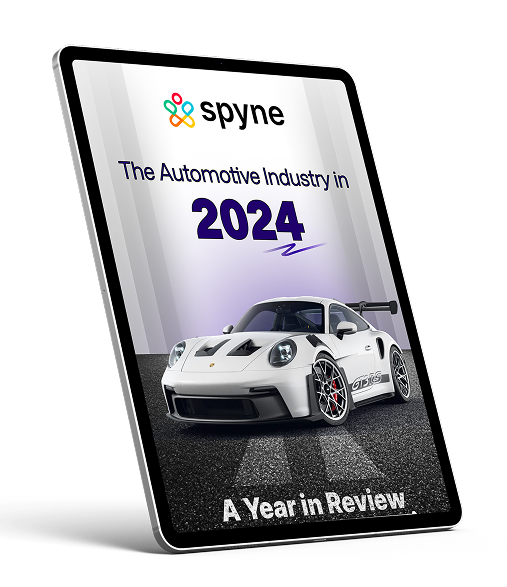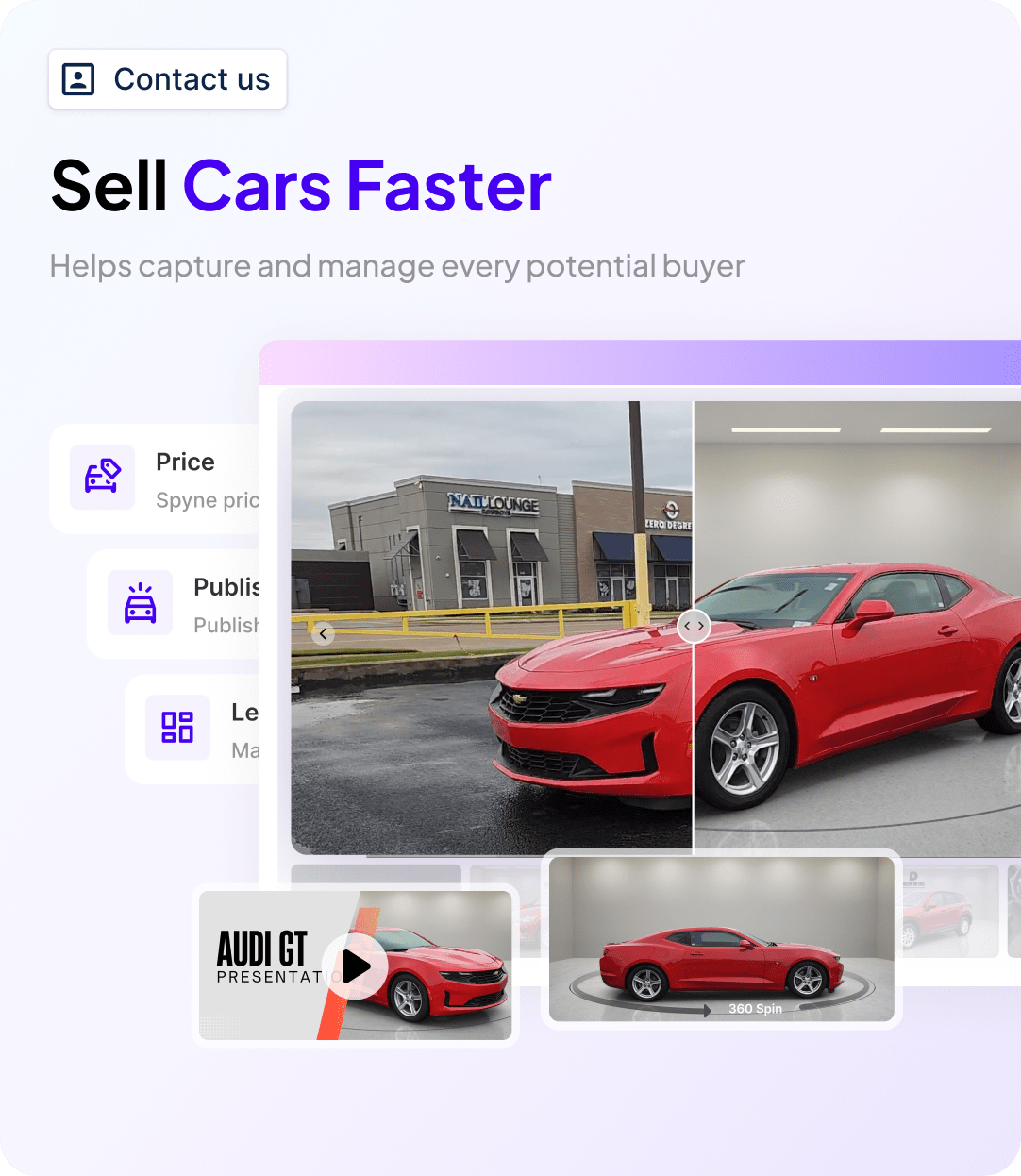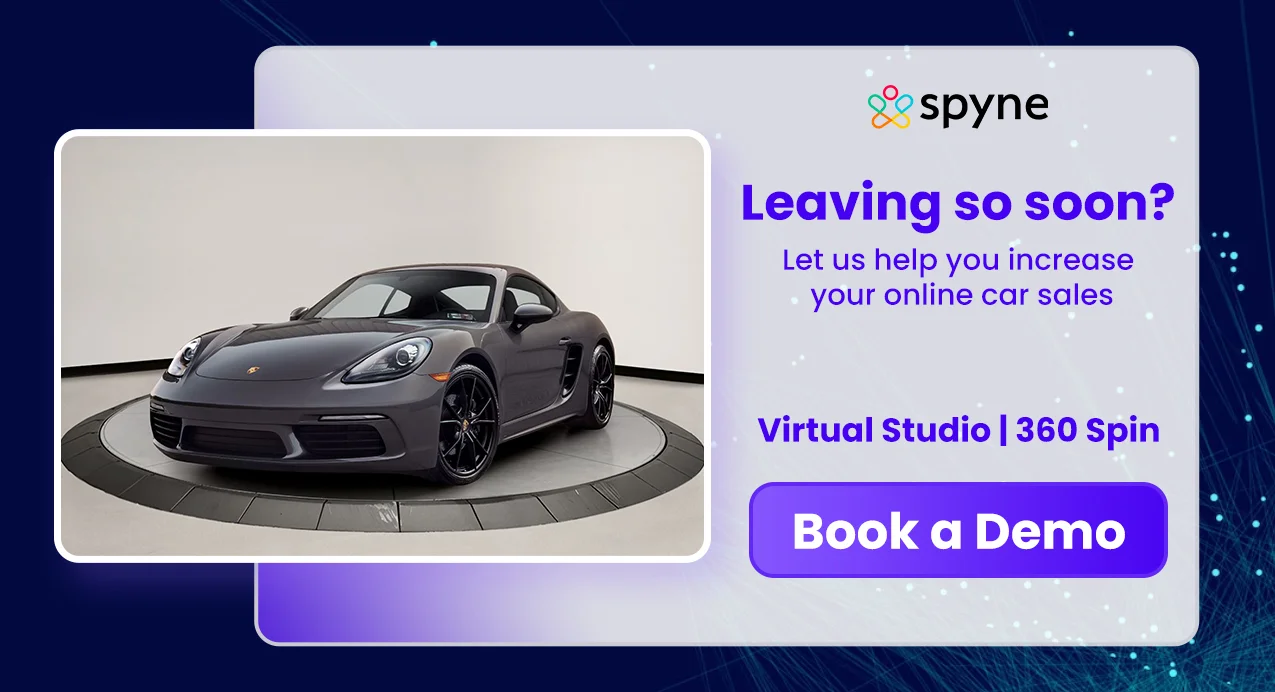Mike owns a used-car dealership in Kansas City. Though business is steady, it has come to his notice that his team works hard, yet most of their day disappears into routine and administrative tasks. Tasks like scheduling service slots, sending maintenance reminders, or answering basic sales questions.
The story is familiar across the country. North American dealerships missed over 175 million calls in 2024, up 15% from the year before. Nearly 1 in 4 customer calls still goes unanswered.
To keep pace, many dealerships are bringing in automotive virtual assistants, digital team members that handle the repetitive load while staying connected to the systems dealers already use.
So what exactly do these automotive virtual personal assistants do, and why are they becoming indispensable to modern dealerships?
What are Automotive Virtual Assistants, and What Do They Do?
An automotive virtual assistant functions as an integrated digital resource built to streamline dealership workflows across sales, service, and customer communication channels. Unlike basic chat interfaces, these systems connect directly to a dealership’s CRM, DMS, and scheduling software to automate time-sensitive interactions that typically tie up the automotive BDC team.
Most conversations are transactional: “Is this car still available?” “Can I book a service for Friday?”. Each needs to be answered but none should require a sales rep’s full attention. A virtual assistant manages that traffic in real time. It logs the lead, assigns it to the right salesperson, sends confirmation messages, and schedules appointments without manual intervention.
Virtual Sales Assistant vs. AI Sales Assistant and How Are They Different?
In dealership conversations, the terms virtual sales assistant and AI sales assistant often get used interchangeably but they’re not quite the same.
A virtual sales assistant is designed to execute, manage calls, schedule appointments, and handle day-to-day coordination. An AI sales assistant, on the other hand, is built to think, analyzing data, identifying buying intent, and learning from every interaction.
Though there is an overlap between the two, it’s easy to blur the lines between them. To make things clear, we’ve broken down the distinction below showing how each contributes to dealership performance in its own way.
| Aspect | Virtual Sales Assistant | AI Sales Assistant |
|---|---|---|
| Core Function | Manages customer interactions and supports sales operations. | Analyzes data to predict buyer intent and enhance sales performance. |
| Technology Base | Works on predefined rules and response flows. | Uses machine learning and natural language processing (NLP). |
| Capabilities | • Can answers customer queries • It can easily schedule test drives • It can compile and analyse sales performance trends. • Can route leads to sales reps |
• Is able to scores and prioritises leads • It suggests best follow-up actions • Does personalised messaging based on user behavior • It can map the user intent and funnel them down |
| Learning Ability | Static (limited to programmed inputs) | Dynamic (continuously improves through interaction data) |
| Role in Dealerships | Acts as a digital coordinator ensuring no lead goes unanswered. | Functions as an intelligent assistant that drives lead conversion and revenue. |
| Human Involvement | Needs regular monitoring and updates. | Operates with minimal supervision, automating key sales tasks. |
| End Result | Consistent communication and improved efficiency. | Smarter engagement and measurable sales growth. |
Top Featured Benefits of Automotive Virtual Assistants
An Automotive Virtual Assistant (AVA) works as an operational layer between your customers and your internal systems, automating communication loops that typically drain your BDC, service desk, or sales coordinators. Below are some benefits that high-performing dealerships are already realizing.
1. Faster Lead Response
Acting as an AI receptionist it can instantly captures and replies to leads from AutoTrader, Facebook Marketplace, or your website through CRM-linked texts and emails, keeping engagement active until your team connects.
2. Smart Follow-Ups & Scheduling
Confirms appointments, sends reminders, and updates CRM records automatically, reducing missed test drives and keeping service bays fully booked.
3. Lower BDC Workload
Handles repetitive tasks like scheduling and lead updates so BDC agents can focus on live conversations and qualified buyers.
4. Clean CRM Data
Syncs lead details, statuses, and results directly into your CRM or DMS, improving reporting accuracy and accountability.
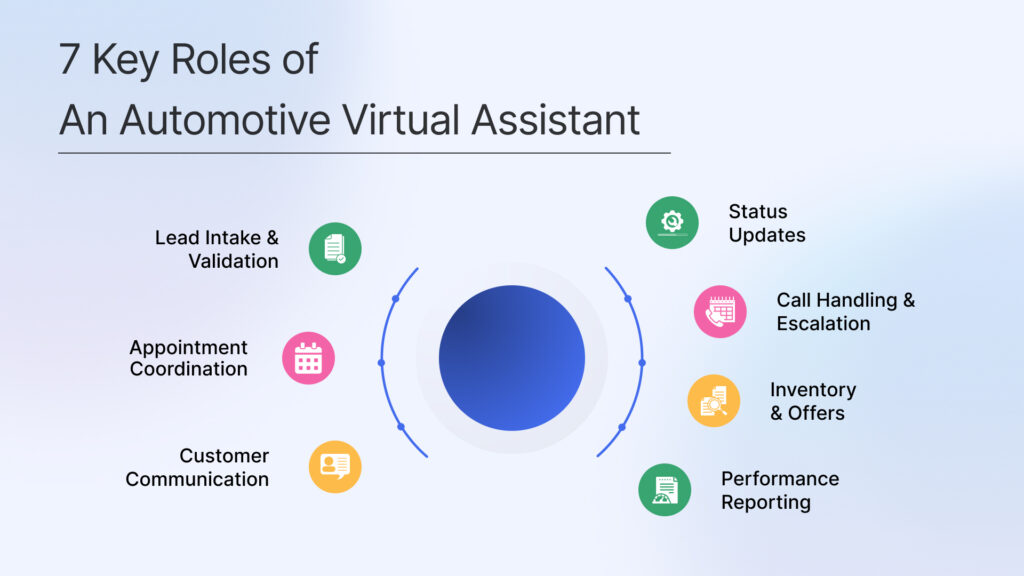
5. 24/7 Coverage
Responds to after-hours messages, price queries, and booking requests, logging every interaction for next-day follow-up without extra payroll costs.
6. Scalable Efficiency
Manages hundreds of conversations at once, supporting growth without new hires or training delays.
7. Higher Customer Satisfaction
A automotive sales solution for a dealership helps with prompt confirmations, accurate service updates, and timely reminders help maintain CSI scores and repeat business.
7 Key Roles and Responsibilities of An Automotive Virtual Assistant
Within a dealership’s workflow, an Automotive Virtual Assistant (AVA) is an intelligent operations node, bridging communication, scheduling, and data synchronization across sales, service, and customer support. Its core roles and responsibilities extend across multiple verticals of dealership management, ensuring continuity and precision in customer engagement.
Lead Intake and Data Validation
Every inbound lead, whether from third-party listing sites, OEM portals, or social campaigns, first lands in the AVA’s processing queue. This automotive answering service parses inquiry data, verifies email and contact accuracy, attaches relevant campaign tags, and injects the validated record into the CRM under the correct source code. This reduces duplicate entries and incorrect lead routing, maintaining clean CRM hygiene for sales and marketing attribution.
Coordination Across Departments
An AVA manages the full lifecycle of appointment workflows. For sales, it checks vehicle availability and allocates time slots directly on the sales advisor’s calendar. For service, it maps technician capacity, lift availability, and parts readiness before confirming bookings. It can also send automated reminders through SMS or WhatsApp and log all confirmations into the DMS or service scheduler.
Customer Communication and Follow-Up Automation
The virtual receptionist operates as the first-response layer for all customer communication channels like calls, emails, live chat, and social inboxes. It acknowledges inquiries instantly, maintains conversation history, and triggers scheduled follow-ups based on the customer’s intent stage (e.g., price inquiry, trade-in request, finance discussion). Follow-up loops are tracked against CRM activity logs, keeping the BDC’s workload streamlined and traceable.
Status Updates and Record Maintenance
Post-interaction, the AVA updates deal stages, task completions, and service status directly into the CRM or dealership ERP. For example, once a test drive is completed, it marks the lead as “demoed” and schedules the next contact interval for the assigned sales representative. In service workflows, it logs completed repair orders, updates warranty records, and adjusts next-service due notifications.
Call Handling and Escalation Routing
Many dealerships integrate their AVA with VoIP or call management systems. When inbound calls spike, the assistant filters basic inquiries like store timings, service status checks, and routes qualified calls to the right department using predefined routing logic. The automotive call tracking can reroute urgent calls (e.g., vehicle delivery or customer complaint) and auto-escalate them to designated managers with full conversation transcripts attached.
Inventory and Offer Communication
The assistant monitors live inventory feeds and OEM offers updates. When a vehicle is booked, sold, or price-adjusted, it triggers the relevant promotional messages or removes outdated listings. This ensures that both digital storefronts and customer communications reflect real-time inventory status, minimizing pricing conflicts and customer dissatisfaction.
Reporting and Task Reconciliation
Every interaction, booking, or confirmation handled by the AVA feeds into an analytics dashboard. The assistant generates daily activity summaries like open leads, appointment adherence, SLA breaches, and conversion metrics, supporting management reviews and operational audits. These reports help GMs and Internet Sales Directors maintain data-backed accountability across their teams.
How to Use Virtual Assistants to Boost Sales Efficiency?
When bringing virtual assistants into dealership operations, the goal is to enhance how sales teams manage leads, customer communication, and internal coordination. The right assistant should be able to help automotive dealerships with the following:
Lead Response Optimisation
A study found that 42% of dealer leads remain uncontacted for over six hours, a window where buyer intent declines sharply. Virtual Assistants mitigate this by responding instantly through CRM integration. For instance, when a prospect requests a quote on a 2022 F-150 via Autotrader, the VA captures the request, sends an immediate confirmation message, and schedules the lead in the salesperson’s task queue with full context attached. It’s automotive lead response feature can reduce the apparent “first contact latency”, a key metric in BDC performance analytics.
Smart Follow-Up Cadence
Dealers who rely on manual follow-up sequences typically lose track of timing and personalization. Virtual Assistants enforce CRM-synced follow-up cadences based on lead disposition. A report highlighted that stores using an after hours answering service recorded a 27% higher re-engagement rate on dormant leads.
Test Drive and Demo Scheduling
In practice, test-drive coordination consumes disproportionate staff time. A virtual assistant can access calendar APIs, vehicle inventory, and delivery prep queues to auto-schedule and confirm demo drives.
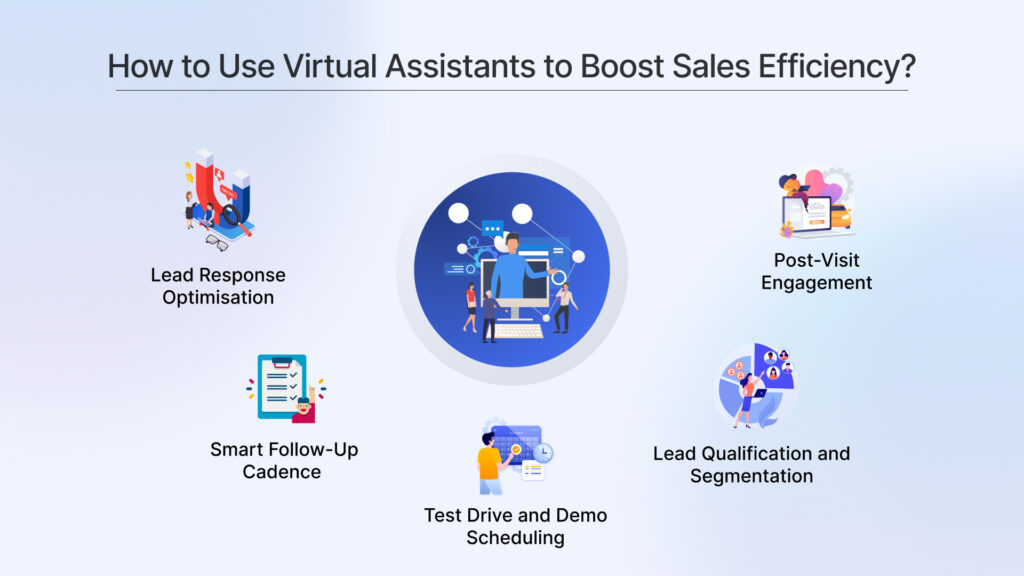
Lead Qualification and Segmentation
Sales staff often waste call time on low-value inquiries such as outdated listings or non-finance-qualified buyers. This AI call bot caA VA pre-qualifies leads using DMS data (trade-in value, credit score range, and historical purchase pattern) before assigning them to reps. This process mirrors what BDCs perform manually but with consistent accuracy and full CRM traceability.
Post-Visit Engagement
Post-demo or post-service interactions define the conversion curve. An automotive chat software would trigger satisfaction checks, upsell prompts, and finance follow-ups based on event markers inside the CRM. For instance, when a customer test-drives a vehicle but hasn’t booked financing, the VA sends a personalized finance quote request 24 hours later.
A 7-Point Checklist for Choosing the Right Virtual Sales Assistant
Selecting the right automotive virtual assistant starts with matching the tool to your dealership’s real workflows. Look for a virtual assistant software for dealers that integrates smoothly with your virtual assistant CRM, supports AI lead nurturing, and connects to a automotive sales consultant for accurate inventory visibility. Learn how dealers can do the same:
1. Define Dealership Goals and Tasks
Start by identifying what specific sales or service processes you want to automate. A virtual sales assistant should complement your in-house BDC or sales desk, not replace them. List key dealership objectives such as faster lead follow-up, better service scheduling, or improved test-drive conversions.
Things to look for:
- Ability to handle your defined sales and service workflows (lead capture, test-drive booking, trade-in assistance, service appointment).
- Configurable playbooks based on lead type like new car, used car, aftersales.
- Customization for different dealership departments (sales, service, finance).
2. Ensure CRM Compatibility
Your virtual sales assistant must fit smoothly into your existing CRM and DMS systems without breaking lead assignment or reporting flows. The sales assistant for an automotive dealership should automatically update lead status, appointment outcomes, and notes in real time.
Things to look for:
- Two-way data sync with your CRM (writeback and read access).
- Automated updates for lead status, follow-up date, and salesperson assignment.
3. Verify Inventory and VIN Data Integration
Inventory visibility is critical because if a virtual assistant can’t pull accurate VIN-level data risks promoting unavailable vehicles. Make sure your assistant mirrors your live DMS inventory and reflects pricing, incentives, and stock availability correctly.
Things to look for:
- Real-time inventory sync with DMS or VDP feeds.
- VIN-based vehicle recognition for precise recommendations.
- Automatic updates for price changes, sold units, or new arrivals.
4. Confirm Compliance and Data Security
Dealerships operate under strict communication and data privacy regulations. The assistant must comply with TCPA, GDPR, and any OEM-specific data handling policies to protect customer information and avoid legal risks.
Things to look for:
- Consent capture and opt-in management for text or email communications.
- Secure data storage with encryption and role-based access control.
- Audit logs for message history and customer interactions.
5. Evaluate Multichannel Communication Capabilities
Your buyers interact across channels like website chat, WhatsApp, SMS, email, and social media. The virtual assistant should unify these conversations and keep them consistent, ensuring no lead slips through.
Things to look for:
- Unified inbox for all communication channels.
- Real-time syncing of messages to CRM profiles.
- Automated routing to live reps when human follow-up is required.
6. Assess Reporting and KPI Alignment
To measure the ROI of your virtual sales assistant, it should map directly to dealership KPIs like lead-to-show ratio, test-drive booking rate, and follow-up completion time. Accurate reporting lets you refine your digital sales strategy.
Things to look for:
- Detailed dashboards for lead source, response time, and conversion tracking.
- Integration with marketing analytics (Google Ads, Meta, etc.) for ROI reporting.
- Custom report scheduling for dealer principals and sales managers.
7. Verify OEM and Franchise Support
If you operate a franchise dealership, the assistant must align with OEM standards for offers, branding, and communication tone. This ensures eligibility for co-op advertising and maintains manufacturer trust.
Things to look for:
- OEM-certified communication templates and promotional language.
- Co-op reporting and campaign tracking compliance.
- Support for multiple rooftops under one dealer group structure.
Hiring the Right Automotive Virtual Assistant for Your Dealership
Car dealerships looking to improve lead handling or service scheduling often turn to outsourced BDC teams or off-the-shelf chat tools. These options help manage volume but rarely align with dealership systems or their sales logic.
Learn How Spyne’s Vini is Powering the Next Gen of Dealership Operations
Spyne’s Conversational AI sales assistant for automotive dealership was developed for such complex workflows. It connects with dealership platforms to manage buyer inquiries, service requests, and inventory conversations around the clock.
Faster Lead Response:
Dealers using Spyne’s virtual assistant reduced average lead response time by up to 60%, ensuring immediate follow-ups on website, WhatsApp, and marketplace inquiries.
Higher Appointment Conversions:
Integrated appointment scheduling through CRM led to a 25% jump in confirmed test drives and showroom visits.
Optimized Service Bay Utilization:
Automated service-slot booking and recall follow-ups improved bay occupancy rates by 18%, directly increasing repair order volumes.
Improved Lead Visibility for Managers:
Real-time dashboards now track lead status, advisor queues, and stock performance across rooftops, replacing manual spreadsheets and fragmented reporting.
A report by Mobility Outlook highlighted how Spyne’s AI-driven retail tools helped used-car dealerships reduce missed inquiries and improve appointment conversions through automated communication and lead tracking.
Future Trends of Automotive Virtual Assistants
As dealerships transform into fully digitized ecosystems, automotive virtual assistants are becoming the intelligent bridge between sales, service & customer experience. A market that is projected to grow from USD 3.5B (2024) to USD 11.2B by 2032 (Verified Market Research).
Emerging trends in 2026 are reshaping dealership automation and customer engagement.
- Multi-Agent Lead Response AI: Unified AI systems boost lead reply rates up to 72%, automating follow-ups, test drives, and intent-based escalation.
- Service-Lane Intelligence: AI-driven fixed-ops tools now power predictive maintenance, smart scheduling, and technician dispatch optimisation.
- Dynamic Inventory & Pricing: Real-time AI analytics adjust pricing, discounts, and bundles based on live demand and competitor data.
- Immersive Customer Journeys: Virtual showrooms, AR previews, and mobile-first paths enhance personalization and in-the-moment engagement.
- Subscription & Predictive Service Models: Integrated finance–maintenance bundles and telematics-based service reminders redefine ownership.
- AI Budget Expansion: Over 80% of dealers plan higher AI spending, prioritising ROI metrics like CSI scores, appointment rates, and service efficiency.
Conclusion
Mike’s story mirrors what most automotive dealers experience, missed calls, unconfirmed appointments, and over burdened teams by repetitive work. Most conversations about automobile sales software skip the real issue: dealership staff spend too much time managing systems instead of customers.
A well-integrated automotive virtual assistant helps address the problem and keeps CRMs updated, schedules organized, and every lead accounted for, so sales and service teams can focus on converting the leads. Car dealerships that want smoother operations and faster responses are moving toward this model because it works.
With Spyne, that shift happens without much effort.
Explore how Spyne manages your sales operations virtually, book a demo today.
FAQs
What is a Sales Assistant for Automotive Dealership?
A sales assistant for automotive dealership helps manage leads, schedule test drives, and follow up with buyers. Modern automotive virtual assistants now automate these tasks, improving response times and conversions across the growing automotive virtual assistant market.
What are Automotive Virtual Personal Assistants?
Automotive virtual personal assistants are AI-powered tools that handle dealership tasks like lead nurturing, appointment booking, and customer support. These assistants boost productivity and streamline communication, forming a key part of the Automotive Virtual Assistant Services ecosystem.
How can automotive virtual assistants improve dealership sales and efficiency?
Automotive virtual assistants handle repetitive tasks like lead follow-ups, appointment scheduling, and customer queries. By automating these workflows, dealerships close more deals and improve team efficiency making Automotive Virtual Assistant Services a key driver of sales growth.
Are AI-powered virtual assistants better than traditional human virtual assistants?
AI-powered automotive virtual personal assistants respond instantly, work 24/7, and integrate with dealer systems. Unlike human assistants, they ensure no lead is missed, an advantage that’s reshaping the automotive virtual assistant market.
Yes. Most Virtual Assistant Software for Dealers integrates directly with CRMs and DMS tools. This allows automotive virtual assistants to sync customer data, track interactions, and automate follow-ups, streamlining sales and service operations.
How do virtual assistants enhance customer experience at car dealerships?
Automotive virtual assistants offer quick, personalized responses, book test drives, and provide real-time updates. This seamless interaction improves satisfaction and builds trust making Automotive Virtual Assistant Services essential for modern dealerships.
Is it safe to use virtual assistants with customer data?
Yes. Reputable Virtual Assistant Software for Dealers follows strict data protection standards, ensuring customer details remain encrypted and secure. Reliable automotive virtual assistant platforms comply with privacy laws and dealership data policies.
How much does it cost to implement an Automotive Virtual Assistant?
The cost of Automotive Virtual Assistant Services varies by features, scale, and integration needs. Basic plans start affordably, while advanced automotive virtual assistant solutions with AI and CRM integration may cost more but deliver higher long-term ROI.
How do dealerships measure ROI from virtual assistant software?
Dealerships track ROI from Virtual Assistant Software for Dealers by measuring faster response times, higher lead conversions, and reduced missed inquiries. Effective automotive virtual assistant services often show measurable gains in sales efficiency and customer retention within weeks of deployment.
Where Can You Hire Automotive Virtual Assistants?
If you’re looking to hire skilled automotive virtual assistants, here are some trusted platforms and companies to consider:
-Spyne: A leading provider of Automotive Virtual Assistant Services, Spyne offers AI-powered and human-assisted solutions designed specifically for automotive dealerships.
-Workstaff360: Specializes in trained automotive virtual personal assistants who can handle sales coordination, customer support, and data entry for dealerships.
-Virtalent: Offers experienced virtual assistant software for dealers, focusing on admin and marketing tasks that free up dealership teams.
-MyOutDesk: A well-known global VA company providing dedicated sales assistants for automotive dealerships, with flexible hiring options and CRM-trained staff.





